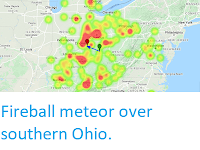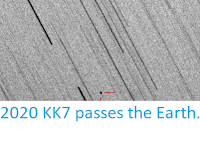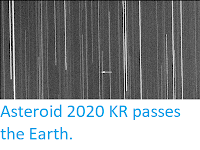Asteroid 2000 LD passed by the Earth at a distance of about 306 800
km (0.80 times the average distance between the Earth and the Moon, or 0.21% of the distance between the Earth and the Sun), slightly before 8.25 am
GMT on Friday 5 June 2020. There was no danger of
the asteroid hitting us, though were it to do so it would have
presented a considerable threat. 2000 LD has an estimated
equivalent
diameter of 63-200 m (i.e. it is estimated that a spherical object with
the same volume would be 63-200 m in diameter), and an object at the
upper end of this range would be predicted to be capable of passing
through the Earth's
atmosphere relatively intact, impacting the ground directly with an
explosion that would be 15 000 times as powerful as the
Hiroshima
bomb. Such an impact would result in an impact crater roughly 3 km in
diameter
and devastation on a global scale, as well as climatic effects that
would last years or even decades.
2020 LD was discovered on 7 June 2020 (two days after its closest approach to the Earth) by the Atlas MLO Telescope at Mauna Loa Observatory in Hawaii. The designation 2020 LD implies that the asteroid was the fourth object (object D -
in numbering asteroids the letters A-Z, excluding I, are assigned
numbers from 1 to 24, with a number added to the end each time the
alphabet is ended, so that A = 1, A1 = 25, A2 = 49, etc., which means that D = 4) discovered in the second half of June 2020 (period 2020 L - the
year being split into 24 half-months represented by the letters A-Y, with I being excluded).
2020 LD has an 493 day (1.35 year) orbital period and an eccentric orbit
tilted at an angle of 3.44° to the plane of the Solar System, which
takes it from 0.24 AU from the Sun (i.e. 24% of the the average distance at
which the Earth orbits the Sun, considerably inside the orbit of the planet Mercury) to 2.20 AU from the Sun (i.e. 220% of
the
average distance at which the Earth orbits the Sun, more than the distance at which Mars orbits the Sun). It is therefore
classed as an
Apollo Group Asteroid (an asteroid that is on average further from the
Sun than the Earth, but which does get closer).
This means that close
encounters between the asteroid and Earth are fairly common, with the
last thought to have happened in May July 2016 and the next predicted
in June 2024.
Asteroid 2020 LD also has regular close encounters with the planet
Mercury, which it last came close to in December 2018, Venus, which it last came close to in May this year (2020) and is next expected to
approach in April 2024, and Mars, which it last came close
to in November 1978 and is expected to pass again in December 2025.
Asteroids
which make close passes to multiple planets are considered to be in
unstable orbits, and are often eventually knocked out of these orbits by
these encounters, either being knocked onto a new, more stable orbit,
dropped into the Sun, knocked out of the Solar System or occasionally
colliding with a planet.
See also...
Follow Sciency Thoughts on Facebook.







